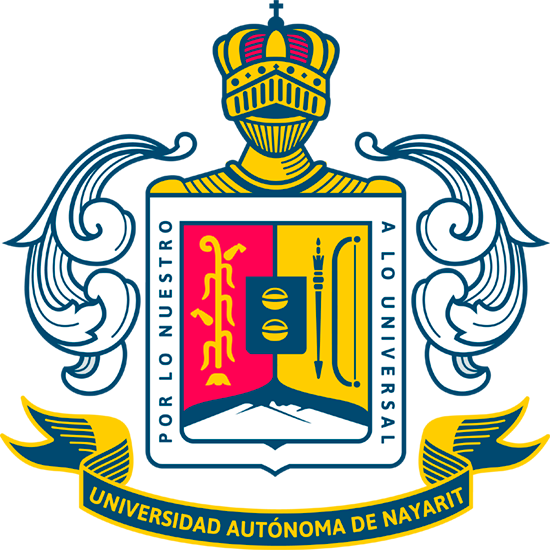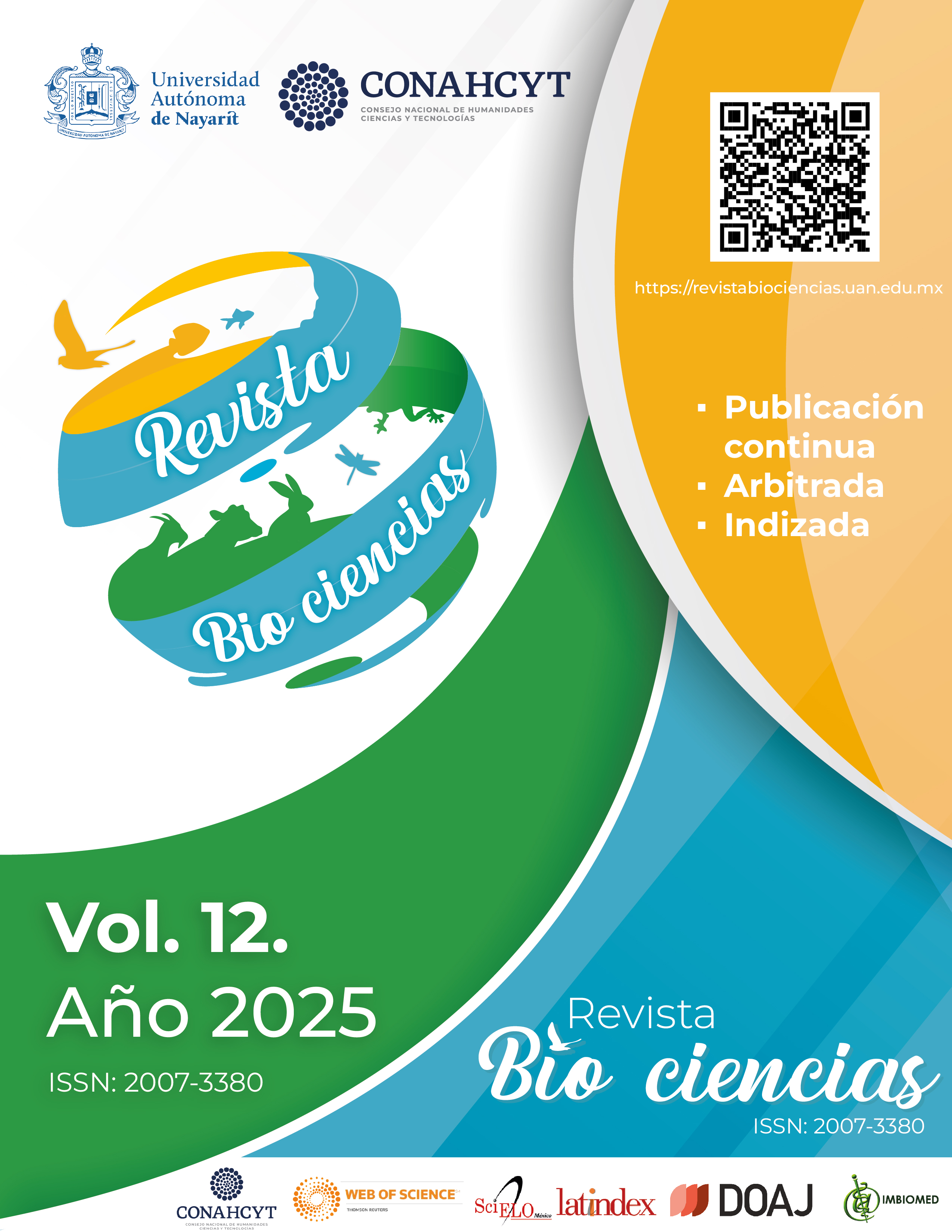Resumen
Huanglongbing es provocada por la bacteria Candidatus liberibacter que ocasiona pérdidas citrícolas a nivel internacional. El objetivo, fue sintetizar nanopartículas de plata para el control de HLB en cítricos. Estas nanopartículas se utilizaron sobre plantas de limón persa enfermas de HBL. En total se realizaron seis tratamientos: 1) T1: Control; 2) T2: Peróxido de hidrógeno, 3) T3: Nanopartículas de plata; 4) T4: Nanopartículas y Peróxido de hidrógeno; 5) T5: Nanopartículas, Peróxido de hidrógeno y fertilización orgánica y 6) T6: Nanopartículas, Peróxido de hidrógeno y fertilización química. Los resultados indicaron que los tratamientos (T5 y T6) que incluyen nanopartículas, mostraron mejor efecto respecto al resto de tratamientos. Las plantas tratadas con nanopartículas mostraron la aparición de nuevos brotes, disminución de coloración amarilla de las hojas, incluso la nervadura central de las hojas no mostró engrosamiento. La evaluación de este tipo de NpAg + H2O2 y fertilizaciones, mostraron resultados prometedores para el control de HLB. Sin embargo, será importante evaluar el mejor tratamiento en una mayor extensión de cultivo de cítricos y demostrar en futuros estudios mediante pruebas moleculares que lo aquí planteado sirve para controlar HLB, tal como se mostró con la prueba presuntiva utilizada.
Citas
Ahmad, P. (2014). Oxidative Damage to Plants – Antioxidant Networks and Signaling. Pp. 65-88. Academic Press, Elsevier Inc., New York.
Arnon, D. I. (1949). Copper enzymes in isolated chloroplasts. Polyphenoloxidase in Beta vulgaris. Plant Physiology, 24(1), 1-15. https://doi.org/10.1104/pp.24.1.1
Bassanezi, R. B., Belasque, J., & Montesino, L. H. (2013). Frequency of symptomatic trees removal in small citrus blocks on citrus huanglongbing epidemics. Crop Protection, 52, 72–77. https://doi.org/10.1016/j.cropro.2013.05.012
Boina, D. R., & Bloomquist, J. R. (2015). Chemical control of the Asian citrus psyllid and of huanglongbing disease in citrus. Pest Management Science, 71(6), 808–823. https://doi.org/10.1002/ps.3957
Chen, X., & Schluesener, H. J. (2008). Nanosilver: A nanoproduct in medical application. Toxicology Letters, 176(1), 1-12. https://doi.org/10.1016/j.toxlet.2007.10.004
Dietz, K.-J., Mittler, R., & Noctor, G. (2016). Recent Progress in Understanding the Role of Reactive Oxygen Species in Plant Cell Signaling. Plant Physiology, 171(3), 1535–1539. https://doi.org/10.1104/pp.16.00938
Etxeberria, E., Gonzalez, P., Dawson, W. O., & Spann, T. (2008). Iodine-Based Starch Test to Assist in Selecting Leaves for HLB Testing. EDIS, 2008(2). https://doi.org/10.32473/edis-hs375-2007
Frank, A. J., Cathcart, N., Maly, K. E., & Kitaev, V. (2010). Synthesis of silver nanoprisms with variable size and investigation of their optical properties: a first-year undergraduate experiment exploring plasmonic nanoparticles. Journal of Chemical Education, 87(10), 1098–1101. https://doi.org/10.1021/ed100166g
Ghosh, D., Kokane, S., Savita, B. K., Kumar, P., Sharma, A. K., Ozcan, A., Kokane, A., & Santra, S. (2022). Huanglongbing Pandemic: Current Challenges and Emerging Management Strategies. Plants, 12(1), 160. https://doi.org/10.3390/plants12010160
Gill, S. S., & Tuteja, N. (2010). Reactive oxygen species and antioxidant machinery in abiotic stress tolerance in crop plants. Plant Physiology and Biochemistry, 48(12), 909-930. https://doi.org/10.1016/j.plaphy.2010.08.016
González, M., Rodríguez, G., M., Hernández, M. I.; Rodríguez, C., Rieumont, J., Cuesta, Er., Sardinas, C., & Morales, A. (2005). Obtención de un fertilizante de liberación lenta y controlada enriquecido con diferentes plantas marinas. Revista Cubana de Química, 8 (3), 25-31.
Habibullah, C., Saravaiya, S. N., Tandel, Y. N., Kumarm S., Paterland, N. B., & Golakiya, P. D. (2019). Effect of Foliar Application of Micronutrients on Growth and Yield of Tomato under Protected. Trends in Biosciences, 10(14), 2491-2495
Hernández-Landa, L., López-Collado, J., Nava-Tablada, M. E., García-García, C. G., & Osorio-Acosta, F. (2017). Percepción de la problemática del Huanglongbing por agentes relevantes en zonas urbanas. Revista Mexicana de Ciencias Agrícolas, 8(4). https://doi.org/10.29312/remexca.v8i4.23.
Hu, J., Jiang, J., & Wang, N. (2018). Control of citrus Huanglongbing via trunk injection of plant defense activators and antibiotics. Phytopathology, 108(2), 186-195. https://doi.org/10.1094/PHYTO-05-17-0175-R
Instituto Nacional de Estadística y Geografía [INEGI]. (2010). Compendio de información geográfica municipal 2010 Gutiérrez Zamora Veracruz de Ignacio de la Llave. In https://www.inegi.org.mx/contenidos/app/mexicocifras/datos_geograficos/30/30069.pdf. Consulted 20 enero 2025
Khaydarov, R. R., Khaydarov, R. R., & Estrin, Y. (2009). Silver particles. In: Linkov, I. and Steevens, J., Eds., Nanomaterials: Risks and Benefits. Springer Science, 287-297.
Ladaniya, M. (2023). Preharvest factors. In Citrus Fruit (pp. 113–144). Elsevier. https://doi.org/10.1016/B978-0-323-99306-7.00010-4
Liao, C., Li, Y., & Tjong, S. C. (2019). Bactericidal and cytotoxic properties of silver nanoparticles. International Journal of Molecular Sciences, 20(2), 449. https://doi.org/10.3390/ijms20020449
Liheng, H., Zhiqiang, G., & Runzhi, L. (2009). Pretreatment of seed with H2O2 enhances drought tolerance of wheat (Triticum aestivum L.) seedlings. African Journal of Biotechnology, 8(22), 6151–6157. https://doi.org/10.5897/AJB09.490
Mittler, R., Vanderauwera, S., Suzuki, N., Miller, G. A. D., Tognetti, V. B., Vandepoele, K., & Van Breusegem, F. (2011). ROS signaling: the new wave?. Trends Plant Science, 16(6), 300-309. https://doi.org/10.1016/j.tplants.2011.03.007
Nazir, F., Fariduddin, Q., & Khan, T. A. (2020). Hydrogen peroxide as a signalling molecule in plants and its crosstalk with other plant growth regulators under heavy metal stress. Chemosphere, 252, 126486. https://doi.org/10.1016/j.chemosphere.2020.12648
Noorizadeh, S., Golmohammadi, M., Bagheri, A., & Bertaccini, A. (2022). Citrus industry: Phytoplasma-associated diseases and related challenges for Asia, America and Africa. Crop Protection, 151, 105822. https://doi.org/10.1016/j.cropro.2021.105822
Pal, S., Tak, Y. K., & Song, J. M. (2007). Does the antibacterial activity of silver nanoparticles depend on the shape of the nanoparticle? A study of the gram-negative bacterium Escherichia coli. Applied and Environmental Microbiology, 73(6), 1712-1720. https://doi.org/10.1128/AEM.02218-06
Pérez-González, O., Gomez-Flores, R., & Tamez-Guerra, P. (2022). Insight into Biological Control Potential of Hirsutella citriformis against Asian Citrus Psyllid as a Vector of Citrus Huanglongbing Disease in America. Journal of Fungi, 8(6), 573. https://doi.org/10.3390/jof8060573
Rai, M., Kon, K., Ingle, A., Duran, N., Galdiero, S. & Galdiero, M. (2014). Broad-spectrum bioactivities of silver nanoparticles: the emerging trends and future prospects. Applied Microbiology Biotechnology, 98(5), 1951-1961. https://doi.org/10.1007/s00253-013-5473-x
Robles-González, M. M., Velázquez-Monreal, J. J., Manzanilla-Ramirez, M. Á.,Orozco-Santos, M., Medina-Urrutia, V. M., López-Arroyo, J. I., & Flores-Virgen, R. (2013). Huanglongbing (HLB) DISEASE IN mexican lime TREES [Citrus aurantifolia (Christm) Swingle] and its dispersion in Colima state, MEXICO. Revista Chapingo Serie Horticultura, XIX(1), 15–31. https://doi.org/10.5154/r.rchsh.2012.01.005
Takushi, T., Toyozato, T., Kawano, S., Taba, S., Taba, K., Ooshiro, A., Numazawa, M., & Tokeshi, M. (2007). Scratch method for simple, rapid diagnosis of citrus huanglongbing using iodine to detect high accumulation of starch in the citrus leaves. Japanese Journal of Phytopathology, 73(1), 3–8. https://doi.org/10.3186/jjphytopath.73.3
Thakuria, D., Chaliha, C., Dutta, P., Sinha, S., Uzir, P., Singh, S. B., Hazarika, S., Sahoo, L., Kharbikar, L. L., & Singh, D. (2023). Citrus Huanglongbing (HLB): Diagnostic and management options. Physiological and Molecular Plant Pathology, 125, 102016. https://doi.org/10.1016/j.pmpp.2023.102016
Uddling, J., Gelang-Alfredsson, J., Piikki, K., & Pleijel, H. (2007). Evaluating the relationship between leaf chlorophyll concentration and SPAD-502 readings. Photosynthesis Research, 91(1), 37-46. https://doi.org/10.1007/s11120-006-9077-5.
Ul Islam, S.N., Asgher, M., & Khan, N.A. (2023). Hydrogen Peroxide and Its Role in Abiotic Stress Tolerance in Plants. In: Fatma, M., Sehar, Z., Khan, N.A. (eds) Gasotransmitters Signaling in Plant Abiotic Stress. Signaling and Communication in Plants. Springer, Cham. https://doi.org/10.1007/978-3-031-30858-1_9
Wang, X., Xu, H., & Pei, H. (2023). Comparing the Effects and Mechanisms of Action of Permanganate, Chlorine, and Hydrogen Peroxide on the Membrane Integrity of Pseudanabaena sp. Cells. ACS ES&T Water, 3(2), 588–597. https://doi.org/10.1021/acsestwater.2c00573
Zhang, M., Guo, Y., Powell, C. A., Doud, M. S., Yang, C., & Duan, Y. (2014). Effective Antibiotics against ‘Candidatus liberibacter asiaticus’ in HLB-Affected Citrus Plants Identified via the Graft-Based Evaluation. PLoS ONE, 9(11), e111032. https://doi.org/10.1371/journal.pone.0111032
Zhang, X. F., Liu, Z. G., Shen, W., & Gurunathan, S. (2016). Silver Nanoparticles: Synthesis, Characterization, Properties, Applications, and Therapeutic Approaches. International journal of molecular sciences, 17(9), 1534. https://doi.org/10.3390/ijms17091534

Revista Bio Ciencias por Universidad Autónoma de Nayarit se encuentra bajo una Licencia Creative Commons Atribución-NoComercial-SinDerivadas 4.0 Unported.
Basada en una obra en http://biociencias.uan.edu.mx/.
Permisos que vayan más allá de lo cubierto por esta licencia pueden encontrarse en http://editorial.uan.edu.mx/index.php/BIOCIENCIAS.licencia de Creative Commons Reconocimiento-NoComercial-SinObraDerivada 4.0 Internacional






